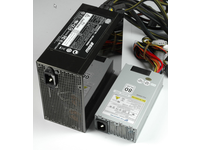G31 And E7200: The Real Low-Power Story
Performance And Efficiency Basics
Performance Basics
There are a few things you need to know in order to assemble a desktop system that is fast enough for everyday work. The following recommendations apply to mainstream PC users who don’t want to spend a fortune as they work in Windows, modern applications, and with multimedia data; our recommendations will not be suitable for power users and enthusiasts.
- Be sure to get a reasonable dual core processor, which should be a Core 2 Duo E7000- or E8000-class chip (45 nm). AMD has competitive products with its Phenom X3, but these products require more power. Four cores are clearly more expensive, require more power, and are only faster if applications can take advantage of multiple cores. A decent dual core will provide high system responsiveness and sufficient performance for your daily routine, and you can always upgrade to a quad core if needed.
Our 2008 CPU Charts provide benchmark comparisons of today’s most relevant desktop processors.
- A discrete graphics card is necessary if you want substantial 3D graphics performance for games or other 3D applications, or if you want to attach multiple displays. You also need one if you insist on specific acceleration features, such as HD video playback acceleration by AMD/ATI or Nvidia, or application acceleration as emerging with Nvidia’s Cuda technology. If neither is applicable, integrated graphics are probably sufficient.
- Get at least 2 GB of RAM; even 4 GB memory kits are highly affordable today. Memory timings are secondary, but we recommend going for a brand you trust. If you insert two memory modules into two different memory channels you’ll ensure that the memory runs in dual-channel mode, which offers the best performance.
- Get a fast hard drive and insist on the latest model generation for performance reasons. Although prices have dropped considerably, there are still noticeable difference among similar products.
Our 3.5” Hard Drive Charts show the benchmark results of most of the latest desktop hard drives.
The question of how much performance you really need depends on what you want to do with your PC. We recommend always going for the fastest hard drive possible, as this is still the slowest core component inside your PC. Flash-based solid state drives have the potential to be many times faster, but you’ll also spend many times the amount you typically need for a hard drive. Currently, you get the best bang for the buck at capacity points of 500 GB, 640 GB or 750 GB with the Samsung Spinpoint F, Seagate’s Barracuda 7200.11, and the Western Digital Caviar Blue.
Differences between a 2.5 GHz processor and an identical 3 GHz model are only really noticeable if you require substantial performance for applications. As long as you don’t have such requirements, you should go for the model that provides the best cost per gigahertz within a product line. Search for the best processor stepping to make sure that you get the latest revision; for Core 2 processors this is currently the M0 stepping, which we used for this review—it requires less idle power than older versions.
Efficiency Basics
Stay on the Cutting Edge
Join the experts who read Tom's Hardware for the inside track on enthusiast PC tech news — and have for over 25 years. We'll send breaking news and in-depth reviews of CPUs, GPUs, AI, maker hardware and more straight to your inbox.

It is important to use a power supply that is efficient in its power specifications and to match the power supply to the expected power requirements to make sure the PSU can operate within a high efficiency range.
When selecting components for an efficient PC, it is important to start with the one component that has the most influence on system power consumption: the power supply unit. Though most of the branded power supplies comply with 80 Plus recommendations, which means that they reach 80% or more energy efficiency at popular load levels, you will still receive disappointing efficiency if you get a PSU that does not match your power requirements. A 1,000 W PSU running at only 40 W power requirements will not be efficient at all, which is why we decided to go for a suitable PSU: Fortron’s FSP220 at a maximum output of 220 W. It will not allow us to install a fast graphics card, but it is sufficient to run the Core 2 Duo on an integrated motherboard with a few drives. It would even suffice for a Core 2 Quad processor.
Once you’re sure that the power supply is appropriately efficient, you should pick your system components according to the efficiency principle. Going for low-cost hardware doesn’t mean getting efficient parts, and going for expensive high-end components typically doesn’t gain you any efficiency benefits either. There are a few basics to stick to: more components, such as additional storage controllers on a motherboard, increase your overall power consumption, as do multi-phase voltage regulators. Low clock speeds (FSB speed, memory speed) as well as low supply voltages help in optimizing power consumption. As a result, high-end or high-speed components should always be avoided if they are not necessary for your applications.
Selecting a few components with a focus on efficiency doesn’t help much. You have to pick all components with regards to efficiency if you really want to bring power consumption down. The results of this effort are impressive, as you’ll see in the benchmark section.
Current page: Performance And Efficiency Basics
Prev Page Combining Performance and Efficiency Next Page Intel G31 Express ChipsetMost Popular

